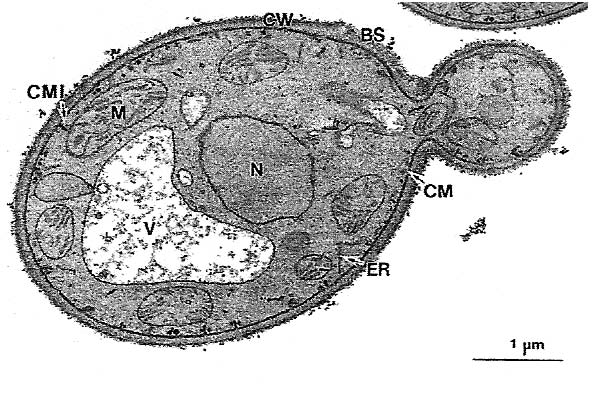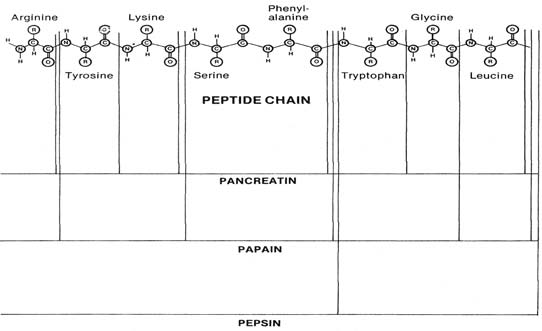Research at the Institute of Technology, Tralee is currently
investigating the possibility of using spent yeast cells from alcohol fermentations as a source of derivatives for nutritional fortification and flavour improvement in human food ingredients. Currently large quantities of yeast of this kind are used as an animal feed with no further processing.
Figure 1
shows a yeast cell and its ultrastructural features. It is now clear that a wide variety of biologically useful products can be extracted from various components of the "yeast factory". The external cell wall consists of layers of glucan, mannan, protein and chitin. The cell membrane consists largely of lipoprotein, and proteins, both intracellular and of the cell envelope, represent 45-50% of the dry weight of yeast cells Ribonucleic acid (RNA) represents approximately 95% of total nucleic acids in yeast.
 Figure 1. The Yeast Factory � transmission electron micrograph of a yeast cell components being used as source of natural ingredients, (magnification x 21000). CW = cell wall; CM = cell membrane; N = nucleus; ER = endoplasmic reticulum; G = Golgi apparatus; V = vacuole; BS = birth scar.
To date, research at I.T.T. has shown that the production of value added natural extracts from yeast are proving to be effective methods of utilising yeast, particularly in the area of natural flavoured products. Use of enzyme technology is proving to be a very effective tool in isolation of flavour enhancers. These are generally considered to be substances that do not have a flavour of their own, but can enhance flavour when added to foods. Examples include certain amino acids and nucleotides derived from the enzymatic hydrolysis of cellular protein and RNA respectively. However, the cell wall which comprises 20% of the total dry weight of yeast is not utilised, and is considered a waste material in yeast extract production. Another project currently underway at I.T.T. is investigating potential applications for yeast cell walls other than in low value animal feeds. The polysaccharide �-glucan, an important component of the yeast cell wall, is being investigated for its suitability as a source of non-caloric food thickeners and dietary fibre. An important research outcome of this project will be a better understanding of structural polysaccharides and glycoproteins in yeast species with the potential for producing a wider range of natural yeast derived food ingredients. This work also compliments research at I.T.T. involving the extraction of polysaccharides from seaweeds for use in foods and in specific biomedical applications.
Figure 1. The Yeast Factory � transmission electron micrograph of a yeast cell components being used as source of natural ingredients, (magnification x 21000). CW = cell wall; CM = cell membrane; N = nucleus; ER = endoplasmic reticulum; G = Golgi apparatus; V = vacuole; BS = birth scar.
To date, research at I.T.T. has shown that the production of value added natural extracts from yeast are proving to be effective methods of utilising yeast, particularly in the area of natural flavoured products. Use of enzyme technology is proving to be a very effective tool in isolation of flavour enhancers. These are generally considered to be substances that do not have a flavour of their own, but can enhance flavour when added to foods. Examples include certain amino acids and nucleotides derived from the enzymatic hydrolysis of cellular protein and RNA respectively. However, the cell wall which comprises 20% of the total dry weight of yeast is not utilised, and is considered a waste material in yeast extract production. Another project currently underway at I.T.T. is investigating potential applications for yeast cell walls other than in low value animal feeds. The polysaccharide �-glucan, an important component of the yeast cell wall, is being investigated for its suitability as a source of non-caloric food thickeners and dietary fibre. An important research outcome of this project will be a better understanding of structural polysaccharides and glycoproteins in yeast species with the potential for producing a wider range of natural yeast derived food ingredients. This work also compliments research at I.T.T. involving the extraction of polysaccharides from seaweeds for use in foods and in specific biomedical applications.
 Figure 2. Action of various enzymes on peptide chain
An important consequence of investigating yeast proteins is a better understanding of how proteins can be hydrolysed (i.e. fragmented) using proteolytic enzymes to give enhanced functional and nutritional properties. Examples of improved functional properties include changing the texture, solubility, foaming and flavour properties of foods. Future research at I.T.T. will investigate alternative proteins such as soya protein, milk protein and wheat protein as substrates for protease enzymes in producing functional and nutritional protein hydrolysates. By using different proteins in combination with proteases such as papain
(see figure 2)
, it will be possible to produce protein hydrolysates with a wider range of applications. Protein hydrolysates are now becoming quite popular as supplements for human nutrition including nutritional peptides for infant formula. They are also used as functional food ingredients in bakery, confectionery, and dairy products. Laboratory investigations at the Institute of Technology, Tralee, will be vital in identifying conditions for the generation of hydrolysates with desirable functional and chemical properties. This will include the measurement of parameters such as degree of hydrolysis, amino nitrogen, soluble nitrogen and peptide and amino acid composition.
Figure 2. Action of various enzymes on peptide chain
An important consequence of investigating yeast proteins is a better understanding of how proteins can be hydrolysed (i.e. fragmented) using proteolytic enzymes to give enhanced functional and nutritional properties. Examples of improved functional properties include changing the texture, solubility, foaming and flavour properties of foods. Future research at I.T.T. will investigate alternative proteins such as soya protein, milk protein and wheat protein as substrates for protease enzymes in producing functional and nutritional protein hydrolysates. By using different proteins in combination with proteases such as papain
(see figure 2)
, it will be possible to produce protein hydrolysates with a wider range of applications. Protein hydrolysates are now becoming quite popular as supplements for human nutrition including nutritional peptides for infant formula. They are also used as functional food ingredients in bakery, confectionery, and dairy products. Laboratory investigations at the Institute of Technology, Tralee, will be vital in identifying conditions for the generation of hydrolysates with desirable functional and chemical properties. This will include the measurement of parameters such as degree of hydrolysis, amino nitrogen, soluble nitrogen and peptide and amino acid composition.
Contact: Brendan Mc Carra,
Chemical & Life Sciences Department,
School of Science, Institute of Technology,
Tralee, Co. Kerry; Tel: 066 7145616, ext. 2387; Fax: 066 7145651;
E-mail:
[email protected]
|


